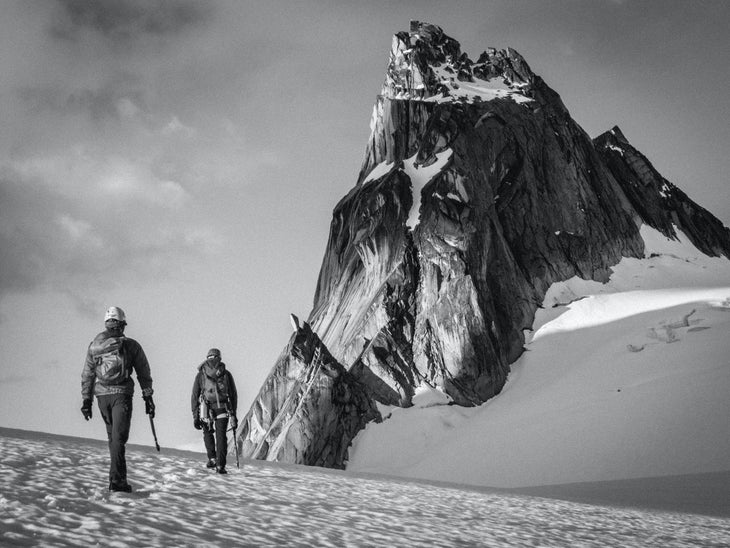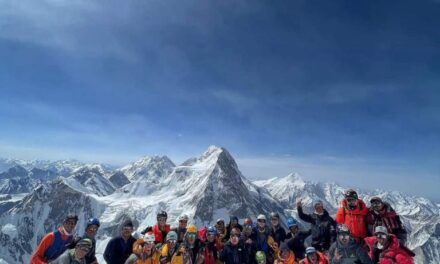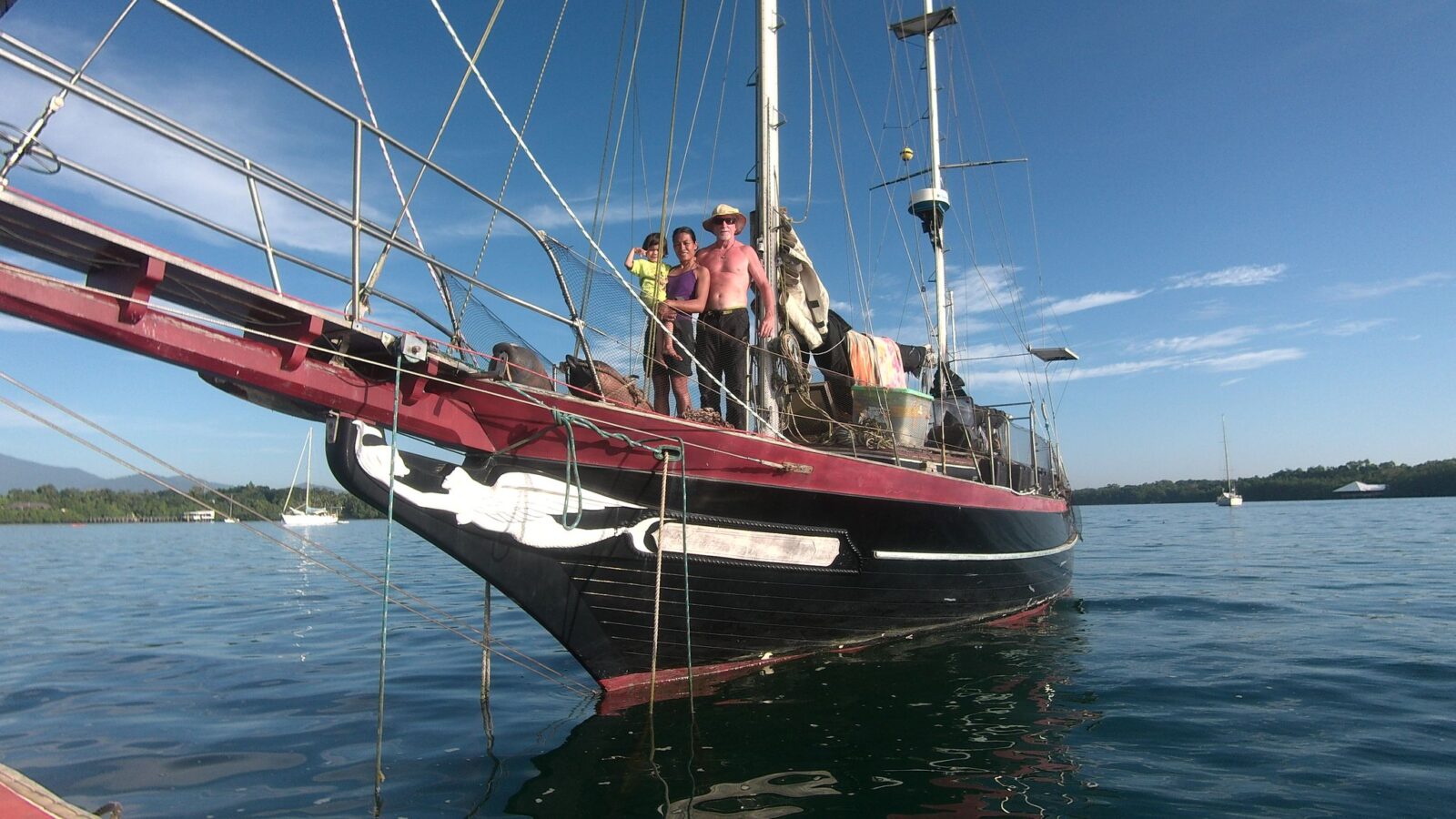
Want to Get into Alpine Climbing? Here’s How to Get Started.
“Alpine climbing seems like a great way to escape the crowds, but a little intimidating. What’s a good progression?”
Get full access to Outside Learn, our online education hub featuring in-depth fitness, nutrition, and adventure courses and more than 2,000 instructional videos when you sign up for Outside+ Sign up for Outside+ today.
“How can I get into alpine climbing? It seems like a great way to escape the crowds, but a little intimidating. What’s a good progression?”
—Joanna W.
The truth is that you’re right on both counts. A lot of alpine climbing is staring out at a snow-drifted expanse of wild, gorgeous, untouched rock—and trying not to poop your pants. That is to say, it’s a great way to find beauty and solitude, but it’s uncomfortable a lot of the time.
However, the discomfort factor can vary a lot depending on what you mean by “alpine climbing.”

What is alpine climbing anyway?
Alpine climbing is technically defined as climbing anywhere in the alpine zone, or above a treeline. That includes alpine bouldering and high-elevation sport climbing, as well as the remote, wind-blasted peaks you’re probably referring to when you mention the intimidation factor. Alpine climbing can also mean ice- and mixed-climbing above treeline. In some parts of the country, like in the Pacific Northwest, some alpine rock is only accessible via glaciated terrain and steep snow, which require other skill sets.
If you’re just looking for solitude, the long approaches often required for alpine bouldering or sport cragging could be all you need. If that’s the case, great! All you need to do is pack some extra layers and safety gear, and be hyper-aware of the weather.
If you’re interested in multi-pitch routes or long traverses, though, first be warned: This is where the discomfort factor ratchets up.
Why does alpine climbing sometimes suck?
Let’s start with the aforementioned gastrointestinal distress. That can come from two sources. The first source: Alpine climbing is scary. Above treeline, weather is unpredictable. Vicious melt-freeze cycles often leave the rock fractured and loose, and rockfall is a serious hazard. Plus, bad rock is hard to protect. The second source: Alpine climbing, by definition, takes place at a relatively high altitude. Different people react to altitude in different ways. Some get light-headed. Some get nauseous. Some produce astonishing levels of gas and find their bowels demanding attention at inopportune moments. (You can’t call someone an alpine climbing partner until you’ve pooped beside them at a hanging belay.)
- Trying to become a better climbing? Take Conrad Anchor’s “Climbing Essentials” Coarse on Outside Learn.
But even those who acclimatize to the altitude—or don’t get any symptoms of altitude sickness in the first place—still feel fatigued and move more slowly in the thin, oxygen-poor air, especially above 8,000 or so feet. Usually, this would be fine. But in many alpine settings, like throughout the Rockies, afternoon thunderstorms are common. Paradoxically, moving fast becomes critical in the very setting where it’s hardest to do. Maybe you’ve heard the term “alpine start”? That means waking up early—as early as 1:00 or 2:00 AM—to leave plenty of time to get back below the treeline before the lighting risk arrives around noon.
Why is the suckage worth it?
If you decide to get into alpine climbing, you’ll wake up heinously early. You’ll climb with frozen hands, shout to your partner over 30-mph winds, dodge hailstorms, re-climb pitches to free hopelessly stuck ropes, and spend an uncomfortable amount of time wondering exactly how loose is too loose when it comes to placing gear in total choss. It’s part of the game. And, in some masochistic way, it’s part of the fun.
- Afraid of falling? Take Arno Ilgner’s “Overcome Your Fear of Falling” Course on Outside Learn
Alpine climbing will bring you wild adventure, access to pristine landscapes, and routes so long and so beautiful that they’ll make you cry. The trick to enjoying it all safely, though, is easing into it the right way. This brings me to your questions.
How to get into alpine climbing
I’ve taken all the following steps on my journey to becoming an alpine climber. If I had to do it over, I’d take them in this order.
- Become a proficient trad climber. Work on your multi-pitch transitions, rappelling efficiency, improvised anchors, and gear placements until you feel confident in your ability to move safely and smoothly in any terrain. You can learn a lot by reading a book or taking an online course, but learning from a human being is invaluable. Find a mentor, or take an in-person class. I personally learned from a handful of experienced friends over two or three years. Then I took a one-day anchor-building course through REI, just to get some official affirmation that I was doing everything right.
- Spend time at altitude. If you want to push your limits on lead, first make sure your lungs and gut can take the strain of altitude. Speed-hike a peak the same elevation as your prospective climb to understand how your body reacts. Example: I knew I ultimately wanted to climb technical routes on 14,259-foot Longs Peak. So I hiked the non-technical trail to the top as fast as I could. (I didn’t puke, and so proceeded to the next step.)
- Dial in any skills for the approach. Depending on where you live, you might have to cross glaciers or climb snow to reach the technical alpine rock. Again, find an experienced mentor to show you the ropes, then work those skills in the field. Before I climbed the North Cascades’ Torment-Forbidden Traverse, for example, my partner and I practiced crevasse rescue systems at home and in the gym, and I went out with another experienced friend to brush up on my self-arrest skills in a snow gully.
- Have a safety plan. Whenever you climb somewhere remote, tell someone at home where you’re going and when to call for help if you’re not back by a certain time. Bring plenty of food, water, and layers in case you get lost or benighted. It’s also smart to pack a personal locator beacon for rescue should a serious emergency arise. Whenever I climb, I bring a headlamp, a first-aid kit, a Garmin inReach Mini, and a pair of walkie-talkies to stay in touch with my partner when they’re beyond yelling distance.
- Get a good partner. Find someone who has the alpine experience and good mountain sense. In the alpine, it’s vital that you have a partner you can trust to make smart decisions and maintain the stoke. You’re probably going to suffer, so pick someone you can have fun suffering with.
- Start small. Start with easy climbing, and start in summer. Summer conditions are more forgiving and the days are longer, giving you more margin for error. I followed friends on alpine routes for a year or two before I organized and led my own climb. For that one, I picked Blitzen Ridge (5.4). At around 13 miles round-trip, it was a long day but well within my climbing ability. It’s a good thing, too, because there were plenty of route-finding difficulties. There was fatigue. And there was certainly gastrointestinal distress. The day was only a success because my partner and I left ourselves a big buffer, both in time and in difficulty.
- Level-up slowly. After your first successful alpine outing, pick something a little harder, either with a longer approach or a tougher grade. Be mindful that both add time and effort, which you’ll have to make up for with better climbing efficiency and sharper route finding.
- Know when to turn around. Alpine climbing puts you at the total mercy of the mountains. Doing it safely means leaving behind the send-at-all-costs mentality and realizing that success often means bailing at just the right time. Good mountain sense involves knowing when conditions, weather, and your timeline are combining to give you a green light, or closing your window faster than you can work with. In the big ranges, summiting is a privilege and an honor, but so is just getting out there in the first place—even if you just end up taking your gear for a walk.



























Recent Comments